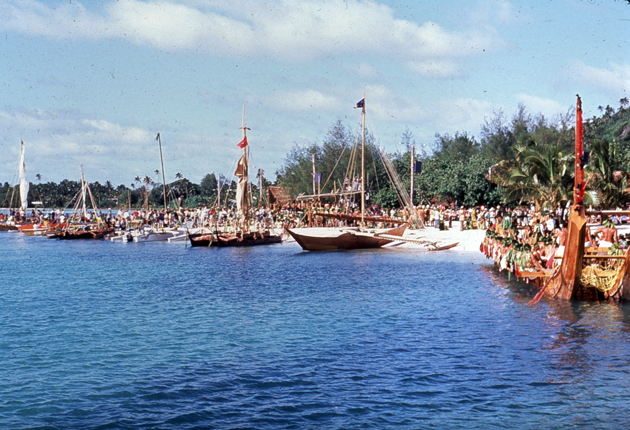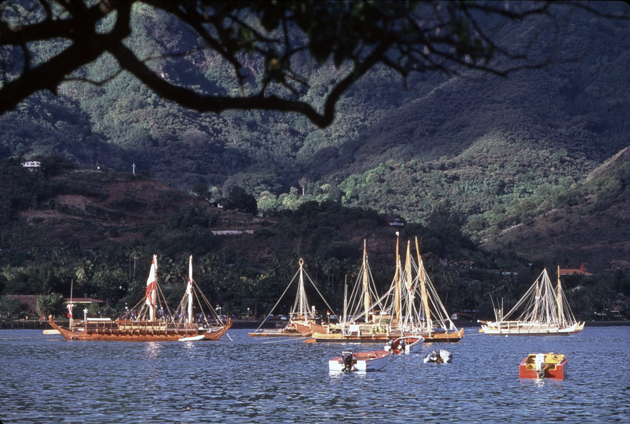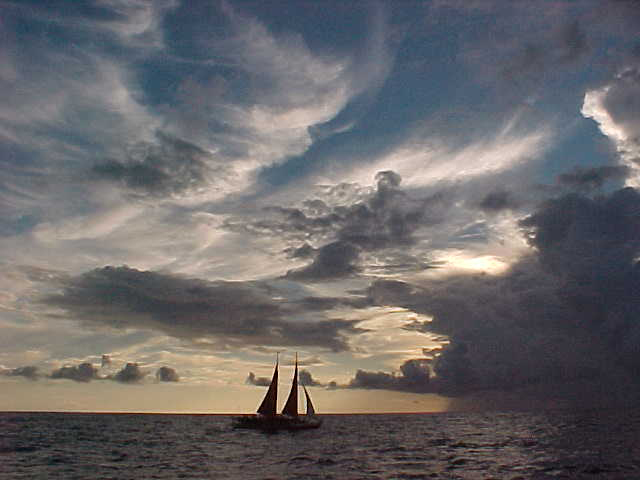‘Ike: Knowledge and Traditions
Voyaging and the Revival of Culture and Heritage
Nainoa Thompson
1976, the first voyage to Tahiti: We were facing cultural extinction. There was no navigator from our culture left. The Polynesian Voyaging Society eventually found a traditional navigator to guide Hokule'a – a very special man. Without him, we have to realize that our voyaging would never have taken place. His name is Mau Piailug and he is from a small island called Satawal in Micronesia.
At the arrival into Papeete Harbor, over half the island was there, more than 17,000 people. The canoe came in, touched the beach.

Pape‘ete Harbor, 1976
There was an immediate response of excitement by everybody, including the children. So many children got onto the canoe they sank the stern. We were politely trying to get them off the rigging and everything else, just for the safety of the canoe.
None of us were prepared for that kind of cultural response -- something very important was happening. These people have great traditions and they have great genealogies of canoes and great navigators. What they didn't have was a canoe. And when Hokule'a arrived at the beach, there was a spontaneous renewal, I think, of both the affirmation of what a great heritage we come from, but also a renewal of the spirit of who we are as a people today.
1980: The difference on the voyage in 1980 (to Tahiti and back) was that Hokule‘a was guided by and captained by people from Hawai'i. For our culture to really be alive, we recognized that we had to practice it ourselves. Our navigator, Mau Pialug, took a fundamental step. He became, instead of our navigator, our teacher.

1985-1987: After we got back from Tahiti, we started thinking about what to do and where would it be important to go to? Other parts of Polynesia have great canoe traditions. We wanted to take Hokule'a to these different places and meet these people. And so we started planning for the Voyage of Rediscovery ... rediscovering ourselves. We mapped out a two-year voyage with seven major legs that reflected the other migratory and voyaging routes of ancient Polynesia-Hawai'i down to Tahiti; Tahiti to the Cook Islands; Rarotonga down to Aotearoa; Aotearoa up to Tonga and Samoa; then against the tradewinds from Samoa to the Cook Islands and back to Tahiti-the west-to-east migration route that Thor Heyerdahl said couldn't be done; Tahiti up to the Marquesas; and finally from the Marquesas back to Hawai'i. The entire voyage would cover 16,000 nautical miles.

1992: The Pacific Arts Festival in 1992 was the joining of Pacific island nations every four years to celebrate the visual and performing arts. It was to be held in Rarotonga. The prime minister of this historic island said, "Let's dedicate it to our historic voyaging ancestors," and he asked that each island group bring a model of their canoes to display. And somebody said, "No, we will sail our canoes." And you know Polynesians, how they are! That challenged everybody else. So they decided to build their canoes. They called Hawai'i and asked for assistance and it was a great opportunity for us to pay back – in a small way – the kindness we found all through the South Pacific. They took care of Hokule'a like she was their own. It also gave us the opportunity to move into a new area - education. We recognized the importance of education in the revival of our culture. In the end, seventeen canoes participated.

1995: The voyage in 1995 was not just about Hokule'a , but rather the children of Hokule'a -- Hawai'i Loa; another Hawaiian canoe called Makali'i; and two canoes from Tahiti, two from Rarotonga, and Te Aurere from Aotearoa. We trained navigators for five years. Recognizing that for our culture to be strong, if navigators are an important part of that, then we have to build strength in our numbers.

1999: We have traveled to the last corner of the Polynesian triangle and that achievement is not just ours - it belongs to everyone who has donated a portion of the millions of man hours spent taking care of the canoe over the almost 25 years since her creation.

What began in 1973 as a scientific experiment to build a replica of a traditional voyaging canoe for a one-time sail to Tahiti, became an important catalyst for a generation of cultural renewal and a symbol of the richness of Hawaiian culture and of a seafaring heritage which links together all of the peoples of Polynesia. No one could have imagined that by the end of the century, Hokule'a will have sailed more than 100,000 miles reaching every corner in the Polynesian Triangle

In 1973 there were no Polynesian voyaging canoes; today, there are six with others under construction. In 1973 there was only one deep-sea navigator that PVS knew of; today there are nine, with several more in training, along with 135 experienced deep-sea sailors in Hawai'i alone, ensuring that the Hawaiian people will never again lose their traditions of voyaging and navigation. In the wake of her accomplishments, Hokule'a has helped to renew the pride that Hawaiian people have for their culture and heritage.
